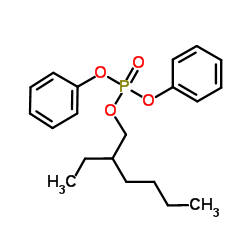Isolation and identification of metabolites of 2-ethylhexyl diphenyl phosphate in rats.
T Nishimaki-Mogami, K Minegishi, A Tanaka, M Sato
Index: Arch. Toxicol. 61(4) , 259-64, (1988)
Full Text: HTML
Abstract
The metabolic fate of 2-ethylhexyl diphenyl phosphate (EHDPP) was studied in male rats. Orally administered 14C-EHDPP was rapidly absorbed and about 80% of the radioactivity was excreted in the urine and feces in the first 24 h. By 7 days, 48% and 52% of the radioactivity was recovered in urine and feces, respectively. Since biliary excretion was low (6% for 2 days), urine seems to be the major excretion route of EHDPP. Radioactivity was widely distributed in all tissues examined. At 2 h, the concentration was relatively high in blood, liver kidney and adipose tissue. The elimination of radioactivity from adipose tissue and liver was somewhat delayed, but almost all the radioactivity was eliminated by 7 days. The major metabolites in the urine were diphenyl phosphate (DPP) and phenol. p-Hydroxyphenyl phenyl phosphate (OH-DPP) and monophenyl phosphate (MPP) were also identified as minor metabolites.
Related Compounds
| Structure | Name/CAS No. | Molecular Formula | Articles |
|---|---|---|---|
 |
2-Ethylhexyldiphenyl phosphate
CAS:1241-94-7 |
C20H27O4P |
|
Migration from plasticized films into foods. 3. Migration of...
1988-01-01 [Food Addit. Contam. 5(1) , 9-20, (1988)] |
|
Size-dependent atmospheric deposition and inhalation exposur...
2016-01-15 [J. Hazard. Mater. 301 , 504-11, (2015)] |
|
[Photometric method of determining di(2-ethylhexyl)phenylpho...
1982-08-01 [Gig. Sanit. (8) , 59-60, (1982)] |
|
[Photometric method of determining diphenyl(2-ethylhexyl) ph...
1983-04-01 [Gig. Sanit. (4) , 42-3, (1983)] |
|
Characterization and application of sodium di(2-ethylhexyl) ...
2004-12-17 [J. Chromatogr. A. 1061(1) , 105-11, (2004)] |